Relationship Management for Account Managers: A Detailed Report
VerifiedAdded on 2019/10/01
|13
|3317
|93
Report
AI Summary
This report delves into the critical aspects of relationship management for account managers, emphasizing strategies for building trust, improving service quality, and maintaining customer loyalty. It explores the importance of understanding competitors, building trust through contractual, competence, and goodwill trust, and providing expertise to enhance productivity. The report also addresses strategies to reduce financial burdens, improve service provision, and maintain account loyalty. Furthermore, it covers developing personal networking communication, the importance of confidentiality and reciprocity, and consultative selling research methods. Stakeholder analysis, monitoring, and controlling in relationship management are also key topics. The report highlights the significance of identifying stakeholder needs and concerns and using KPIs to measure the effectiveness of activities, ultimately contributing to account profitability and organizational growth. The report uses various sources to support its arguments.
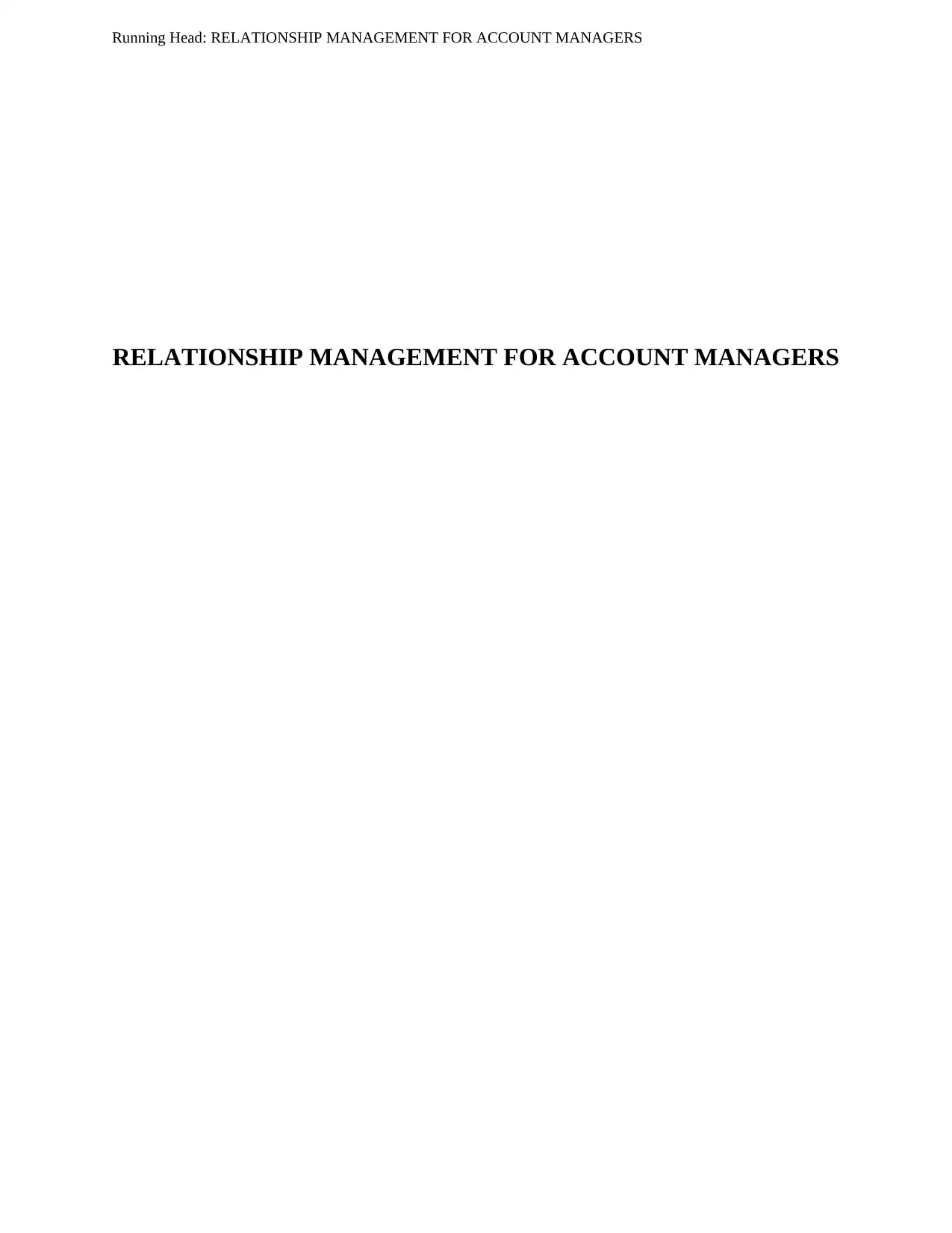
Running Head: RELATIONSHIP MANAGEMENT FOR ACCOUNT MANAGERS
RELATIONSHIP MANAGEMENT FOR ACCOUNT MANAGERS
RELATIONSHIP MANAGEMENT FOR ACCOUNT MANAGERS
Paraphrase This Document
Need a fresh take? Get an instant paraphrase of this document with our AI Paraphraser
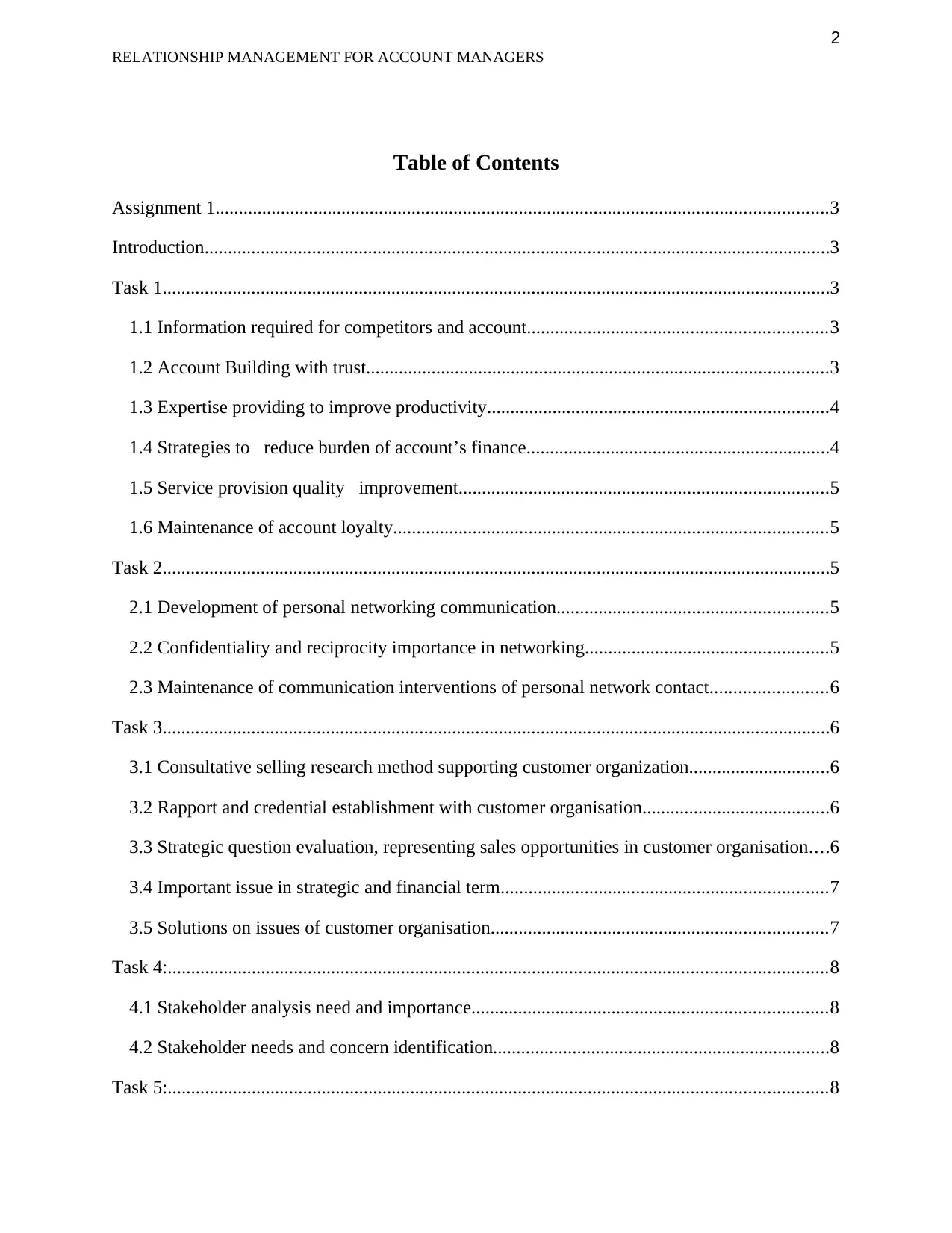
2
RELATIONSHIP MANAGEMENT FOR ACCOUNT MANAGERS
Table of Contents
Assignment 1...................................................................................................................................3
Introduction......................................................................................................................................3
Task 1...............................................................................................................................................3
1.1 Information required for competitors and account................................................................3
1.2 Account Building with trust...................................................................................................3
1.3 Expertise providing to improve productivity.........................................................................4
1.4 Strategies to reduce burden of account’s finance.................................................................4
1.5 Service provision quality improvement...............................................................................5
1.6 Maintenance of account loyalty.............................................................................................5
Task 2...............................................................................................................................................5
2.1 Development of personal networking communication..........................................................5
2.2 Confidentiality and reciprocity importance in networking....................................................5
2.3 Maintenance of communication interventions of personal network contact.........................6
Task 3...............................................................................................................................................6
3.1 Consultative selling research method supporting customer organization..............................6
3.2 Rapport and credential establishment with customer organisation........................................6
3.3 Strategic question evaluation, representing sales opportunities in customer organisation....6
3.4 Important issue in strategic and financial term......................................................................7
3.5 Solutions on issues of customer organisation........................................................................7
Task 4:.............................................................................................................................................8
4.1 Stakeholder analysis need and importance............................................................................8
4.2 Stakeholder needs and concern identification........................................................................8
Task 5:.............................................................................................................................................8
RELATIONSHIP MANAGEMENT FOR ACCOUNT MANAGERS
Table of Contents
Assignment 1...................................................................................................................................3
Introduction......................................................................................................................................3
Task 1...............................................................................................................................................3
1.1 Information required for competitors and account................................................................3
1.2 Account Building with trust...................................................................................................3
1.3 Expertise providing to improve productivity.........................................................................4
1.4 Strategies to reduce burden of account’s finance.................................................................4
1.5 Service provision quality improvement...............................................................................5
1.6 Maintenance of account loyalty.............................................................................................5
Task 2...............................................................................................................................................5
2.1 Development of personal networking communication..........................................................5
2.2 Confidentiality and reciprocity importance in networking....................................................5
2.3 Maintenance of communication interventions of personal network contact.........................6
Task 3...............................................................................................................................................6
3.1 Consultative selling research method supporting customer organization..............................6
3.2 Rapport and credential establishment with customer organisation........................................6
3.3 Strategic question evaluation, representing sales opportunities in customer organisation....6
3.4 Important issue in strategic and financial term......................................................................7
3.5 Solutions on issues of customer organisation........................................................................7
Task 4:.............................................................................................................................................8
4.1 Stakeholder analysis need and importance............................................................................8
4.2 Stakeholder needs and concern identification........................................................................8
Task 5:.............................................................................................................................................8

3
RELATIONSHIP MANAGEMENT FOR ACCOUNT MANAGERS
5.1 Monitoring and controlling concept in relationship management.........................................8
5.2 Organisational requirements in controlling and monitoring activities...................................9
5.3 Monitoring of customer activity feedbacks through informal and informal approach..........9
5.4 Strategies to analyse information from controlling and monitoring......................................9
5.5 Weakness and strength of improvement areas and relationship............................................9
Conclusion.......................................................................................................................................9
Reference List................................................................................................................................11
RELATIONSHIP MANAGEMENT FOR ACCOUNT MANAGERS
5.1 Monitoring and controlling concept in relationship management.........................................8
5.2 Organisational requirements in controlling and monitoring activities...................................9
5.3 Monitoring of customer activity feedbacks through informal and informal approach..........9
5.4 Strategies to analyse information from controlling and monitoring......................................9
5.5 Weakness and strength of improvement areas and relationship............................................9
Conclusion.......................................................................................................................................9
Reference List................................................................................................................................11
⊘ This is a preview!⊘
Do you want full access?
Subscribe today to unlock all pages.

Trusted by 1+ million students worldwide

4
RELATIONSHIP MANAGEMENT FOR ACCOUNT MANAGERS
Assignment 1
Introduction
Management of relationship with account managers is one of the factors, which need to be
properly maintained in an organisation, in order to reduce the potential risks of organisation.
However, different strategies can be approached in order to build trust with accounts, which can
help the organisation to gain proper resources and financial requirements and thus ultimately
helps an organisation to be established.
This course study highlights on information, which are required for competitors and account with
gaining trust, along with providing expertise in order to improve organizational productivity.
In addition to that, this study demonstrates development of network communication in relation to
personal and with stakeholders, with improving quality and service provision. This discourse
demonstrates overall factors, in order to maintain relationship with accounts in an effective
manner.
Task 1
1.1 Information required for competitors and account
In terms of competitors, marketing strategies approached by them needs to be identified, which
can help to gain competitive advantage, through planning and adding unique traits. On the other
hand, as Wood et al. (2014) has commented that, in order to manage the account in a proper
manner, proper information on type of account along with the attractiveness of customer needs,
need to be managed. A key account matrix can be approached, which can help to gain
information on both customers and account. In the opinion of Wild, Wild & Han (2014), key
account matrix will help to measure attractiveness of customers. Information on ability of
customer attractiveness is required for gaining proper stability of account. As DRURY (2013)
has stated that, account matrix can help to gain barriers in measurement of customer
attractiveness, which help to identify the investments of accounts of either high attractiveness or
low attractiveness. If investment will be identified in low attractive customer account, therefore,
proper return of investment will not be gained. In addition to that, in the viewpoint of Hughes
(2016), account matrix can help the sellers to identify key strength of account to business.
1.2 Account Building with trust
In order to build trust with accounts, three different types of trusts are considered in KAM:
Contractual Trust
RELATIONSHIP MANAGEMENT FOR ACCOUNT MANAGERS
Assignment 1
Introduction
Management of relationship with account managers is one of the factors, which need to be
properly maintained in an organisation, in order to reduce the potential risks of organisation.
However, different strategies can be approached in order to build trust with accounts, which can
help the organisation to gain proper resources and financial requirements and thus ultimately
helps an organisation to be established.
This course study highlights on information, which are required for competitors and account with
gaining trust, along with providing expertise in order to improve organizational productivity.
In addition to that, this study demonstrates development of network communication in relation to
personal and with stakeholders, with improving quality and service provision. This discourse
demonstrates overall factors, in order to maintain relationship with accounts in an effective
manner.
Task 1
1.1 Information required for competitors and account
In terms of competitors, marketing strategies approached by them needs to be identified, which
can help to gain competitive advantage, through planning and adding unique traits. On the other
hand, as Wood et al. (2014) has commented that, in order to manage the account in a proper
manner, proper information on type of account along with the attractiveness of customer needs,
need to be managed. A key account matrix can be approached, which can help to gain
information on both customers and account. In the opinion of Wild, Wild & Han (2014), key
account matrix will help to measure attractiveness of customers. Information on ability of
customer attractiveness is required for gaining proper stability of account. As DRURY (2013)
has stated that, account matrix can help to gain barriers in measurement of customer
attractiveness, which help to identify the investments of accounts of either high attractiveness or
low attractiveness. If investment will be identified in low attractive customer account, therefore,
proper return of investment will not be gained. In addition to that, in the viewpoint of Hughes
(2016), account matrix can help the sellers to identify key strength of account to business.
1.2 Account Building with trust
In order to build trust with accounts, three different types of trusts are considered in KAM:
Contractual Trust
Paraphrase This Document
Need a fresh take? Get an instant paraphrase of this document with our AI Paraphraser
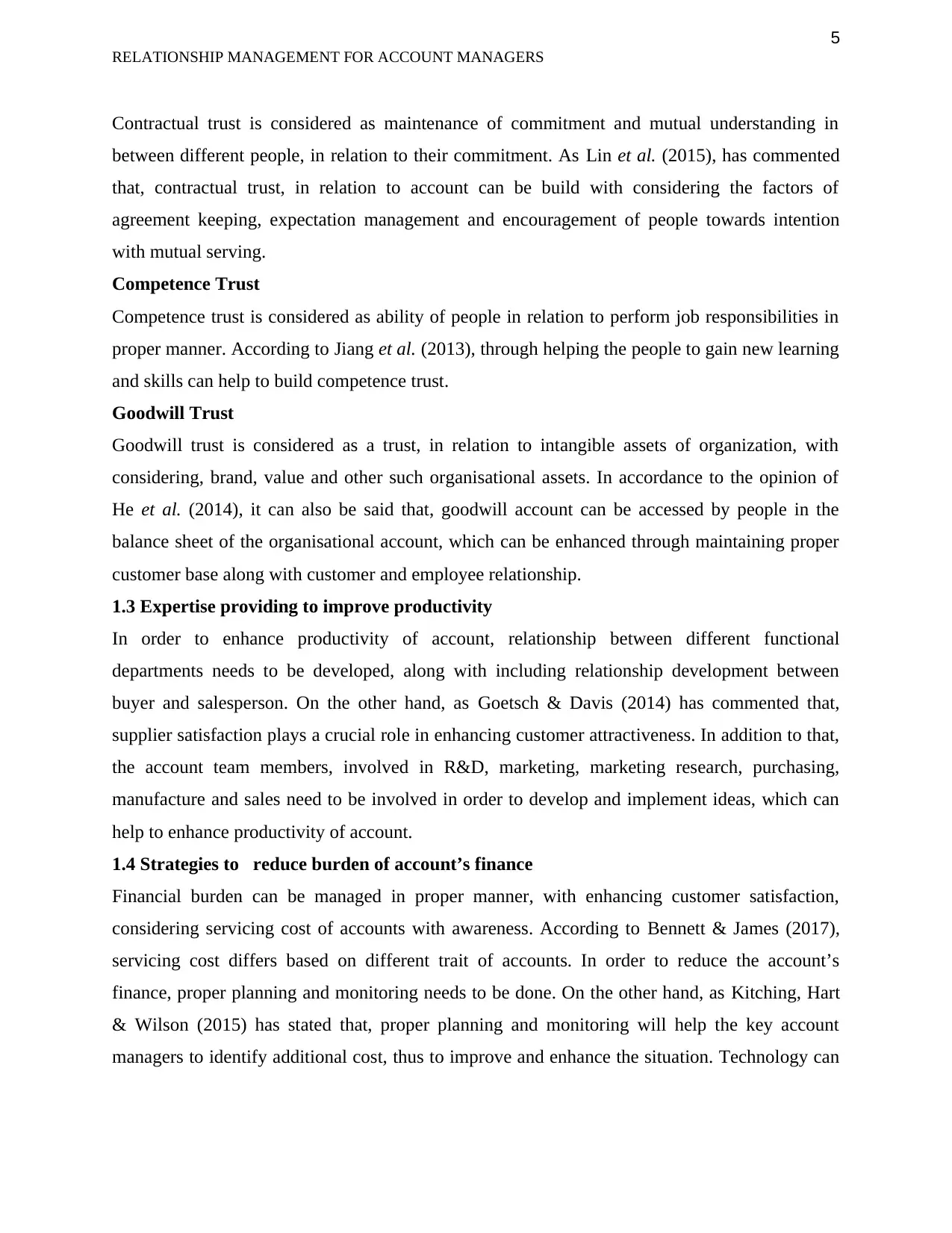
5
RELATIONSHIP MANAGEMENT FOR ACCOUNT MANAGERS
Contractual trust is considered as maintenance of commitment and mutual understanding in
between different people, in relation to their commitment. As Lin et al. (2015), has commented
that, contractual trust, in relation to account can be build with considering the factors of
agreement keeping, expectation management and encouragement of people towards intention
with mutual serving.
Competence Trust
Competence trust is considered as ability of people in relation to perform job responsibilities in
proper manner. According to Jiang et al. (2013), through helping the people to gain new learning
and skills can help to build competence trust.
Goodwill Trust
Goodwill trust is considered as a trust, in relation to intangible assets of organization, with
considering, brand, value and other such organisational assets. In accordance to the opinion of
He et al. (2014), it can also be said that, goodwill account can be accessed by people in the
balance sheet of the organisational account, which can be enhanced through maintaining proper
customer base along with customer and employee relationship.
1.3 Expertise providing to improve productivity
In order to enhance productivity of account, relationship between different functional
departments needs to be developed, along with including relationship development between
buyer and salesperson. On the other hand, as Goetsch & Davis (2014) has commented that,
supplier satisfaction plays a crucial role in enhancing customer attractiveness. In addition to that,
the account team members, involved in R&D, marketing, marketing research, purchasing,
manufacture and sales need to be involved in order to develop and implement ideas, which can
help to enhance productivity of account.
1.4 Strategies to reduce burden of account’s finance
Financial burden can be managed in proper manner, with enhancing customer satisfaction,
considering servicing cost of accounts with awareness. According to Bennett & James (2017),
servicing cost differs based on different trait of accounts. In order to reduce the account’s
finance, proper planning and monitoring needs to be done. On the other hand, as Kitching, Hart
& Wilson (2015) has stated that, proper planning and monitoring will help the key account
managers to identify additional cost, thus to improve and enhance the situation. Technology can
RELATIONSHIP MANAGEMENT FOR ACCOUNT MANAGERS
Contractual trust is considered as maintenance of commitment and mutual understanding in
between different people, in relation to their commitment. As Lin et al. (2015), has commented
that, contractual trust, in relation to account can be build with considering the factors of
agreement keeping, expectation management and encouragement of people towards intention
with mutual serving.
Competence Trust
Competence trust is considered as ability of people in relation to perform job responsibilities in
proper manner. According to Jiang et al. (2013), through helping the people to gain new learning
and skills can help to build competence trust.
Goodwill Trust
Goodwill trust is considered as a trust, in relation to intangible assets of organization, with
considering, brand, value and other such organisational assets. In accordance to the opinion of
He et al. (2014), it can also be said that, goodwill account can be accessed by people in the
balance sheet of the organisational account, which can be enhanced through maintaining proper
customer base along with customer and employee relationship.
1.3 Expertise providing to improve productivity
In order to enhance productivity of account, relationship between different functional
departments needs to be developed, along with including relationship development between
buyer and salesperson. On the other hand, as Goetsch & Davis (2014) has commented that,
supplier satisfaction plays a crucial role in enhancing customer attractiveness. In addition to that,
the account team members, involved in R&D, marketing, marketing research, purchasing,
manufacture and sales need to be involved in order to develop and implement ideas, which can
help to enhance productivity of account.
1.4 Strategies to reduce burden of account’s finance
Financial burden can be managed in proper manner, with enhancing customer satisfaction,
considering servicing cost of accounts with awareness. According to Bennett & James (2017),
servicing cost differs based on different trait of accounts. In order to reduce the account’s
finance, proper planning and monitoring needs to be done. On the other hand, as Kitching, Hart
& Wilson (2015) has stated that, proper planning and monitoring will help the key account
managers to identify additional cost, thus to improve and enhance the situation. Technology can
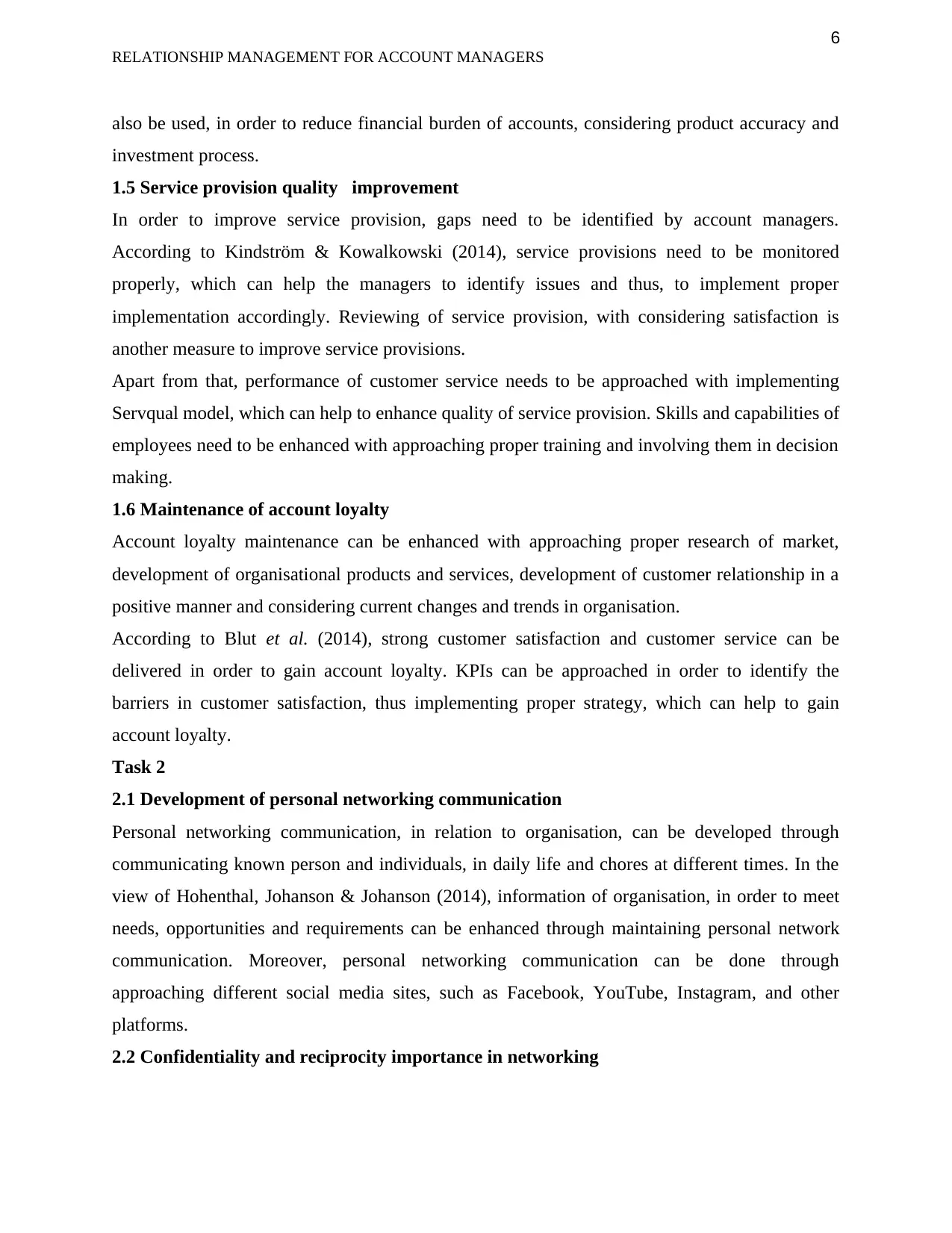
6
RELATIONSHIP MANAGEMENT FOR ACCOUNT MANAGERS
also be used, in order to reduce financial burden of accounts, considering product accuracy and
investment process.
1.5 Service provision quality improvement
In order to improve service provision, gaps need to be identified by account managers.
According to Kindström & Kowalkowski (2014), service provisions need to be monitored
properly, which can help the managers to identify issues and thus, to implement proper
implementation accordingly. Reviewing of service provision, with considering satisfaction is
another measure to improve service provisions.
Apart from that, performance of customer service needs to be approached with implementing
Servqual model, which can help to enhance quality of service provision. Skills and capabilities of
employees need to be enhanced with approaching proper training and involving them in decision
making.
1.6 Maintenance of account loyalty
Account loyalty maintenance can be enhanced with approaching proper research of market,
development of organisational products and services, development of customer relationship in a
positive manner and considering current changes and trends in organisation.
According to Blut et al. (2014), strong customer satisfaction and customer service can be
delivered in order to gain account loyalty. KPIs can be approached in order to identify the
barriers in customer satisfaction, thus implementing proper strategy, which can help to gain
account loyalty.
Task 2
2.1 Development of personal networking communication
Personal networking communication, in relation to organisation, can be developed through
communicating known person and individuals, in daily life and chores at different times. In the
view of Hohenthal, Johanson & Johanson (2014), information of organisation, in order to meet
needs, opportunities and requirements can be enhanced through maintaining personal network
communication. Moreover, personal networking communication can be done through
approaching different social media sites, such as Facebook, YouTube, Instagram, and other
platforms.
2.2 Confidentiality and reciprocity importance in networking
RELATIONSHIP MANAGEMENT FOR ACCOUNT MANAGERS
also be used, in order to reduce financial burden of accounts, considering product accuracy and
investment process.
1.5 Service provision quality improvement
In order to improve service provision, gaps need to be identified by account managers.
According to Kindström & Kowalkowski (2014), service provisions need to be monitored
properly, which can help the managers to identify issues and thus, to implement proper
implementation accordingly. Reviewing of service provision, with considering satisfaction is
another measure to improve service provisions.
Apart from that, performance of customer service needs to be approached with implementing
Servqual model, which can help to enhance quality of service provision. Skills and capabilities of
employees need to be enhanced with approaching proper training and involving them in decision
making.
1.6 Maintenance of account loyalty
Account loyalty maintenance can be enhanced with approaching proper research of market,
development of organisational products and services, development of customer relationship in a
positive manner and considering current changes and trends in organisation.
According to Blut et al. (2014), strong customer satisfaction and customer service can be
delivered in order to gain account loyalty. KPIs can be approached in order to identify the
barriers in customer satisfaction, thus implementing proper strategy, which can help to gain
account loyalty.
Task 2
2.1 Development of personal networking communication
Personal networking communication, in relation to organisation, can be developed through
communicating known person and individuals, in daily life and chores at different times. In the
view of Hohenthal, Johanson & Johanson (2014), information of organisation, in order to meet
needs, opportunities and requirements can be enhanced through maintaining personal network
communication. Moreover, personal networking communication can be done through
approaching different social media sites, such as Facebook, YouTube, Instagram, and other
platforms.
2.2 Confidentiality and reciprocity importance in networking
⊘ This is a preview!⊘
Do you want full access?
Subscribe today to unlock all pages.

Trusted by 1+ million students worldwide

7
RELATIONSHIP MANAGEMENT FOR ACCOUNT MANAGERS
In terms of sharing information to customers, one needs to deliver more efficiency towards
customer benefit. However, confidentiality needs to be maintained, while delivering information
to customers. As commented by Adekola & Sergi (2016), reciprocity also needs to be mailed, as
individuals will respond to the benefits, which will be gained by them. In terms of information
sharing, both reciprocity and confidentiality plays a crucial role in building trust and relationship,
between a business and customers.
2.3 Maintenance of communication interventions of personal network contact
Regular contacts, with individuals, approaching proper communication mode, such as, face-to-
face interventions and other methods helps to gain network contact. As stated by Kernbach,
Eppler & Bresciani (2015), delivering valuable and beneficiary information to individuals can
help to maintain communication with personal contacts.
Choosing an appropriate communication mode, which can help to interact more, may help to
maintain communication. Moreover, privacy right of the customers need to be respected and
considered while interaction.
Task 3
3.1 Consultative selling research method supporting customer organization
Segmentation is an important aspect in terms of research the prospective customer organisation,
which is required for consultative selling. In the view of Mitchell (2017), market segmentation
with considering customers can help to focus on customer organisation. CRM can also be
approached to identify features of customer organisation. Publications, internet, websites can be
used to research on customer organisation.
3.2 Rapport and credential establishment with customer organisation
Rapport and credential plays a crucial role in building trust and relationship with customers. In
order to build rapport and credentials, common ground can be approached, which can help to
interact with customers and sharing information with common interest issues. According to
Warner, Abel & Hachtmann (2014), pace and lead can be used to build rapport, where
psychological tune are matched up according to customers and thus trust is build.
3.3 Strategic question evaluation, representing sales opportunities in customer organisation
Customer organisational issues can be resolved with approaching questions to the organisation,
considering open ended and closed ended questions. Open ended questions, will allow the
RELATIONSHIP MANAGEMENT FOR ACCOUNT MANAGERS
In terms of sharing information to customers, one needs to deliver more efficiency towards
customer benefit. However, confidentiality needs to be maintained, while delivering information
to customers. As commented by Adekola & Sergi (2016), reciprocity also needs to be mailed, as
individuals will respond to the benefits, which will be gained by them. In terms of information
sharing, both reciprocity and confidentiality plays a crucial role in building trust and relationship,
between a business and customers.
2.3 Maintenance of communication interventions of personal network contact
Regular contacts, with individuals, approaching proper communication mode, such as, face-to-
face interventions and other methods helps to gain network contact. As stated by Kernbach,
Eppler & Bresciani (2015), delivering valuable and beneficiary information to individuals can
help to maintain communication with personal contacts.
Choosing an appropriate communication mode, which can help to interact more, may help to
maintain communication. Moreover, privacy right of the customers need to be respected and
considered while interaction.
Task 3
3.1 Consultative selling research method supporting customer organization
Segmentation is an important aspect in terms of research the prospective customer organisation,
which is required for consultative selling. In the view of Mitchell (2017), market segmentation
with considering customers can help to focus on customer organisation. CRM can also be
approached to identify features of customer organisation. Publications, internet, websites can be
used to research on customer organisation.
3.2 Rapport and credential establishment with customer organisation
Rapport and credential plays a crucial role in building trust and relationship with customers. In
order to build rapport and credentials, common ground can be approached, which can help to
interact with customers and sharing information with common interest issues. According to
Warner, Abel & Hachtmann (2014), pace and lead can be used to build rapport, where
psychological tune are matched up according to customers and thus trust is build.
3.3 Strategic question evaluation, representing sales opportunities in customer organisation
Customer organisational issues can be resolved with approaching questions to the organisation,
considering open ended and closed ended questions. Open ended questions, will allow the
Paraphrase This Document
Need a fresh take? Get an instant paraphrase of this document with our AI Paraphraser
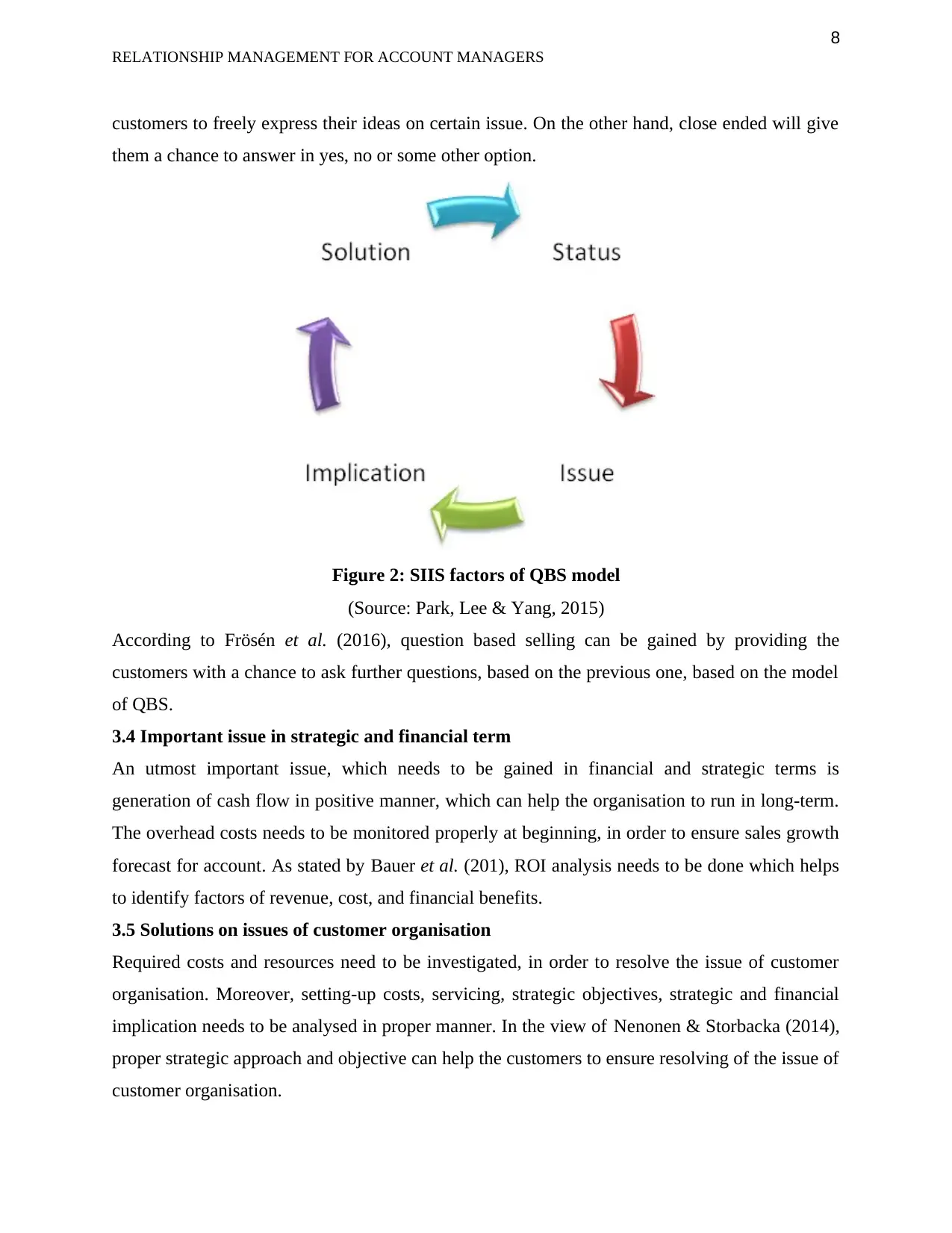
8
RELATIONSHIP MANAGEMENT FOR ACCOUNT MANAGERS
customers to freely express their ideas on certain issue. On the other hand, close ended will give
them a chance to answer in yes, no or some other option.
Figure 2: SIIS factors of QBS model
(Source: Park, Lee & Yang, 2015)
According to Frösén et al. (2016), question based selling can be gained by providing the
customers with a chance to ask further questions, based on the previous one, based on the model
of QBS.
3.4 Important issue in strategic and financial term
An utmost important issue, which needs to be gained in financial and strategic terms is
generation of cash flow in positive manner, which can help the organisation to run in long-term.
The overhead costs needs to be monitored properly at beginning, in order to ensure sales growth
forecast for account. As stated by Bauer et al. (201), ROI analysis needs to be done which helps
to identify factors of revenue, cost, and financial benefits.
3.5 Solutions on issues of customer organisation
Required costs and resources need to be investigated, in order to resolve the issue of customer
organisation. Moreover, setting-up costs, servicing, strategic objectives, strategic and financial
implication needs to be analysed in proper manner. In the view of Nenonen & Storbacka (2014),
proper strategic approach and objective can help the customers to ensure resolving of the issue of
customer organisation.
RELATIONSHIP MANAGEMENT FOR ACCOUNT MANAGERS
customers to freely express their ideas on certain issue. On the other hand, close ended will give
them a chance to answer in yes, no or some other option.
Figure 2: SIIS factors of QBS model
(Source: Park, Lee & Yang, 2015)
According to Frösén et al. (2016), question based selling can be gained by providing the
customers with a chance to ask further questions, based on the previous one, based on the model
of QBS.
3.4 Important issue in strategic and financial term
An utmost important issue, which needs to be gained in financial and strategic terms is
generation of cash flow in positive manner, which can help the organisation to run in long-term.
The overhead costs needs to be monitored properly at beginning, in order to ensure sales growth
forecast for account. As stated by Bauer et al. (201), ROI analysis needs to be done which helps
to identify factors of revenue, cost, and financial benefits.
3.5 Solutions on issues of customer organisation
Required costs and resources need to be investigated, in order to resolve the issue of customer
organisation. Moreover, setting-up costs, servicing, strategic objectives, strategic and financial
implication needs to be analysed in proper manner. In the view of Nenonen & Storbacka (2014),
proper strategic approach and objective can help the customers to ensure resolving of the issue of
customer organisation.
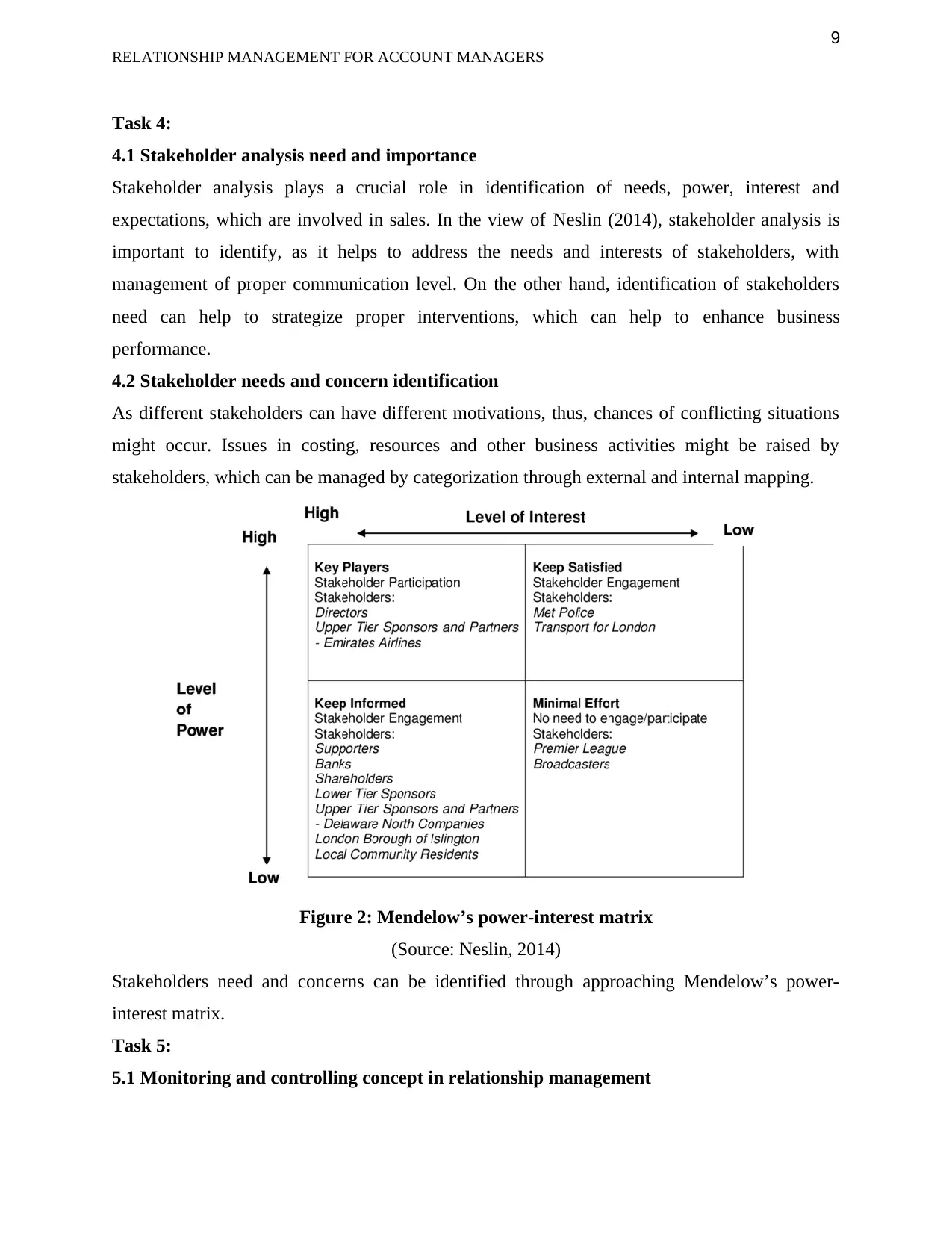
9
RELATIONSHIP MANAGEMENT FOR ACCOUNT MANAGERS
Task 4:
4.1 Stakeholder analysis need and importance
Stakeholder analysis plays a crucial role in identification of needs, power, interest and
expectations, which are involved in sales. In the view of Neslin (2014), stakeholder analysis is
important to identify, as it helps to address the needs and interests of stakeholders, with
management of proper communication level. On the other hand, identification of stakeholders
need can help to strategize proper interventions, which can help to enhance business
performance.
4.2 Stakeholder needs and concern identification
As different stakeholders can have different motivations, thus, chances of conflicting situations
might occur. Issues in costing, resources and other business activities might be raised by
stakeholders, which can be managed by categorization through external and internal mapping.
Figure 2: Mendelow’s power-interest matrix
(Source: Neslin, 2014)
Stakeholders need and concerns can be identified through approaching Mendelow’s power-
interest matrix.
Task 5:
5.1 Monitoring and controlling concept in relationship management
RELATIONSHIP MANAGEMENT FOR ACCOUNT MANAGERS
Task 4:
4.1 Stakeholder analysis need and importance
Stakeholder analysis plays a crucial role in identification of needs, power, interest and
expectations, which are involved in sales. In the view of Neslin (2014), stakeholder analysis is
important to identify, as it helps to address the needs and interests of stakeholders, with
management of proper communication level. On the other hand, identification of stakeholders
need can help to strategize proper interventions, which can help to enhance business
performance.
4.2 Stakeholder needs and concern identification
As different stakeholders can have different motivations, thus, chances of conflicting situations
might occur. Issues in costing, resources and other business activities might be raised by
stakeholders, which can be managed by categorization through external and internal mapping.
Figure 2: Mendelow’s power-interest matrix
(Source: Neslin, 2014)
Stakeholders need and concerns can be identified through approaching Mendelow’s power-
interest matrix.
Task 5:
5.1 Monitoring and controlling concept in relationship management
⊘ This is a preview!⊘
Do you want full access?
Subscribe today to unlock all pages.

Trusted by 1+ million students worldwide

10
RELATIONSHIP MANAGEMENT FOR ACCOUNT MANAGERS
Controlling and monitoring in relationship management helps to identify concerned barriers and
measures, this needs to be enhanced. On the other hand, as Persson (2013) has commented that,
KPI tools can be approached, in order to measure effectiveness of concerned and required
activities. As controlling and monitoring helps to identify concerned potential risks, thus,
enhance account profitability with organisational growth, along with controlling cost and gap
identification.
5.2 Organisational requirements in controlling and monitoring activities
In relation to controlling and monitoring, organisational requirements vary from one organisation
to another, in terms of relationship management. According to Payne (2013), proper controlling
and monitoring can help to gain strong customer satisfaction, along with proper allocation of
costs and resources. In addition to that, account’s forecast growth can be achieved, along with
identification of risks and opportunities.
5.3 Monitoring of customer activity feedbacks through informal and informal approach
An approach of formal feedback in monitoring customer activity can help to identify needs and
requirements of stakeholders, which can be approached through meetings, framing
questionnaires, complaint procedures and other such interventions. As Bennett & James (2017)
have stated that, informal feedback is done verbally. Formal feedback ensures quality delivery of
services and facilities with commitment. On the other hand, informal feedback might include
recommendations.
5.4 Strategies to analyse information from controlling and monitoring
In order to analyse information from controlling and monitoring, proper management of
information needs to be done. MKIS can be approached in order to analyse information, which
are linked with warehouse database, and other systems, from which information can be retrieved.
Regular meetings, monitoring and review can also be approached to analyse information.
5.5 Weakness and strength of improvement areas and relationship
Monitoring and feedbacks can help to gain strengths and weakness. However, SWOT analysis
can be approached, which can help to gain detailed opportunities of growth, weakness, threats
and strength of account. Strategic planning can use findings of SWOT analysis.
Conclusion
From above study, it can be concluded that, maintenance of relationship with customers needs to
be properly monitored and controlled, with considering the needs, requirements, and perspectives
RELATIONSHIP MANAGEMENT FOR ACCOUNT MANAGERS
Controlling and monitoring in relationship management helps to identify concerned barriers and
measures, this needs to be enhanced. On the other hand, as Persson (2013) has commented that,
KPI tools can be approached, in order to measure effectiveness of concerned and required
activities. As controlling and monitoring helps to identify concerned potential risks, thus,
enhance account profitability with organisational growth, along with controlling cost and gap
identification.
5.2 Organisational requirements in controlling and monitoring activities
In relation to controlling and monitoring, organisational requirements vary from one organisation
to another, in terms of relationship management. According to Payne (2013), proper controlling
and monitoring can help to gain strong customer satisfaction, along with proper allocation of
costs and resources. In addition to that, account’s forecast growth can be achieved, along with
identification of risks and opportunities.
5.3 Monitoring of customer activity feedbacks through informal and informal approach
An approach of formal feedback in monitoring customer activity can help to identify needs and
requirements of stakeholders, which can be approached through meetings, framing
questionnaires, complaint procedures and other such interventions. As Bennett & James (2017)
have stated that, informal feedback is done verbally. Formal feedback ensures quality delivery of
services and facilities with commitment. On the other hand, informal feedback might include
recommendations.
5.4 Strategies to analyse information from controlling and monitoring
In order to analyse information from controlling and monitoring, proper management of
information needs to be done. MKIS can be approached in order to analyse information, which
are linked with warehouse database, and other systems, from which information can be retrieved.
Regular meetings, monitoring and review can also be approached to analyse information.
5.5 Weakness and strength of improvement areas and relationship
Monitoring and feedbacks can help to gain strengths and weakness. However, SWOT analysis
can be approached, which can help to gain detailed opportunities of growth, weakness, threats
and strength of account. Strategic planning can use findings of SWOT analysis.
Conclusion
From above study, it can be concluded that, maintenance of relationship with customers needs to
be properly monitored and controlled, with considering the needs, requirements, and perspectives
Paraphrase This Document
Need a fresh take? Get an instant paraphrase of this document with our AI Paraphraser
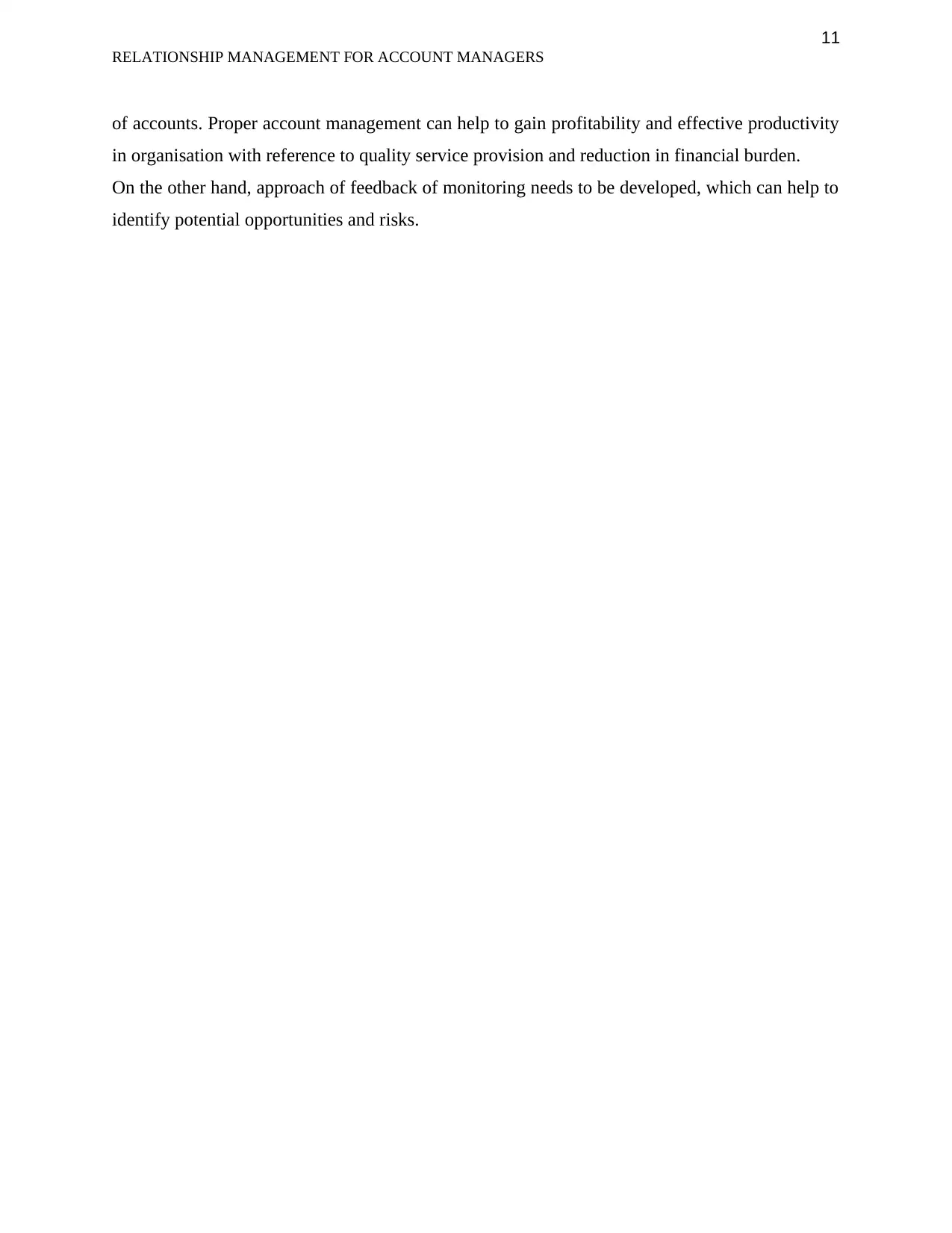
11
RELATIONSHIP MANAGEMENT FOR ACCOUNT MANAGERS
of accounts. Proper account management can help to gain profitability and effective productivity
in organisation with reference to quality service provision and reduction in financial burden.
On the other hand, approach of feedback of monitoring needs to be developed, which can help to
identify potential opportunities and risks.
RELATIONSHIP MANAGEMENT FOR ACCOUNT MANAGERS
of accounts. Proper account management can help to gain profitability and effective productivity
in organisation with reference to quality service provision and reduction in financial burden.
On the other hand, approach of feedback of monitoring needs to be developed, which can help to
identify potential opportunities and risks.

12
RELATIONSHIP MANAGEMENT FOR ACCOUNT MANAGERS
Reference List
Adekola, A., & Sergi, B. S. (2016). Global business management: A cross-cultural perspective.
Abingdon: Routledge.
Bauer, J. C., Schmitt, P., Morwitz, V. G., & Winer, R. S. (2013). Managerial decision making in
customer management: adaptive, fast and frugal?. Journal of the Academy of Marketing
Science, 41(4), 436-455.
Bennett, M., & James, P. (Eds.). (2017). The Green bottom line: environmental accounting for
management: current practice and future trends. Abingdon: Routledge.
Blut, M., Beatty, S. E., Evanschitzky, H., & Brock, C. (2014). The impact of service
characteristics on the switching costs–customer loyalty link. Journal of Retailing, 90(2),
275-290.
Frösén, J., Jaakkola, M., Churakova, I., & Tikkanen, H. (2016). Effective forms of market
orientation across the business cycle: A longitudinal analysis of business-to-business
firms. Industrial Marketing Management, 52, 91-99.
Goetsch, D. L., & Davis, S. B. (2014). Quality management for organizational excellence. Upper
Saddle River, London: Pearson.
Hohenthal, J., Johanson, J., & Johanson, M. (2014). Network knowledge and business-
relationship value in the foreign market. International Business Review, 23(1), 4-19.
Kernbach, S., Eppler, M. J., & Bresciani, S. (2015). The use of visualization in the
communication of business strategies: An experimental evaluation. International Journal
of Business Communication, 52(2), 164-187.
Kindström, D., & Kowalkowski, C. (2014). Service innovation in product-centric firms: A
multidimensional business model perspective. Journal of Business & Industrial
Marketing, 29(2), 96-111.
Kitching, J., Hart, M., & Wilson, N. (2015). Burden or benefit? Regulation as a dynamic
influence on small business performance. International Small Business Journal, 33(2),
130-147.
Mitchell, E. T. (2017). Assessing service quality and organizational goal alignment for service
units. Technical Services Quarterly, 34(4), 388-398.
Nenonen, S., & Storbacka, K. (2014). Management of customer assets for increased value
capture in business markets. Management Decision, 52(1), 101-121.
RELATIONSHIP MANAGEMENT FOR ACCOUNT MANAGERS
Reference List
Adekola, A., & Sergi, B. S. (2016). Global business management: A cross-cultural perspective.
Abingdon: Routledge.
Bauer, J. C., Schmitt, P., Morwitz, V. G., & Winer, R. S. (2013). Managerial decision making in
customer management: adaptive, fast and frugal?. Journal of the Academy of Marketing
Science, 41(4), 436-455.
Bennett, M., & James, P. (Eds.). (2017). The Green bottom line: environmental accounting for
management: current practice and future trends. Abingdon: Routledge.
Blut, M., Beatty, S. E., Evanschitzky, H., & Brock, C. (2014). The impact of service
characteristics on the switching costs–customer loyalty link. Journal of Retailing, 90(2),
275-290.
Frösén, J., Jaakkola, M., Churakova, I., & Tikkanen, H. (2016). Effective forms of market
orientation across the business cycle: A longitudinal analysis of business-to-business
firms. Industrial Marketing Management, 52, 91-99.
Goetsch, D. L., & Davis, S. B. (2014). Quality management for organizational excellence. Upper
Saddle River, London: Pearson.
Hohenthal, J., Johanson, J., & Johanson, M. (2014). Network knowledge and business-
relationship value in the foreign market. International Business Review, 23(1), 4-19.
Kernbach, S., Eppler, M. J., & Bresciani, S. (2015). The use of visualization in the
communication of business strategies: An experimental evaluation. International Journal
of Business Communication, 52(2), 164-187.
Kindström, D., & Kowalkowski, C. (2014). Service innovation in product-centric firms: A
multidimensional business model perspective. Journal of Business & Industrial
Marketing, 29(2), 96-111.
Kitching, J., Hart, M., & Wilson, N. (2015). Burden or benefit? Regulation as a dynamic
influence on small business performance. International Small Business Journal, 33(2),
130-147.
Mitchell, E. T. (2017). Assessing service quality and organizational goal alignment for service
units. Technical Services Quarterly, 34(4), 388-398.
Nenonen, S., & Storbacka, K. (2014). Management of customer assets for increased value
capture in business markets. Management Decision, 52(1), 101-121.
⊘ This is a preview!⊘
Do you want full access?
Subscribe today to unlock all pages.

Trusted by 1+ million students worldwide
1 out of 13
Related Documents
Your All-in-One AI-Powered Toolkit for Academic Success.
+13062052269
info@desklib.com
Available 24*7 on WhatsApp / Email
![[object Object]](/_next/static/media/star-bottom.7253800d.svg)
Unlock your academic potential
Copyright © 2020–2025 A2Z Services. All Rights Reserved. Developed and managed by ZUCOL.





